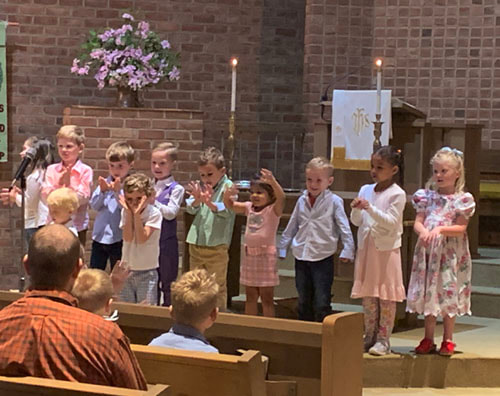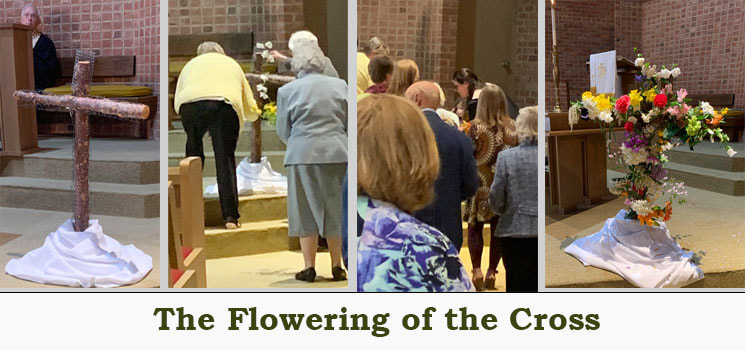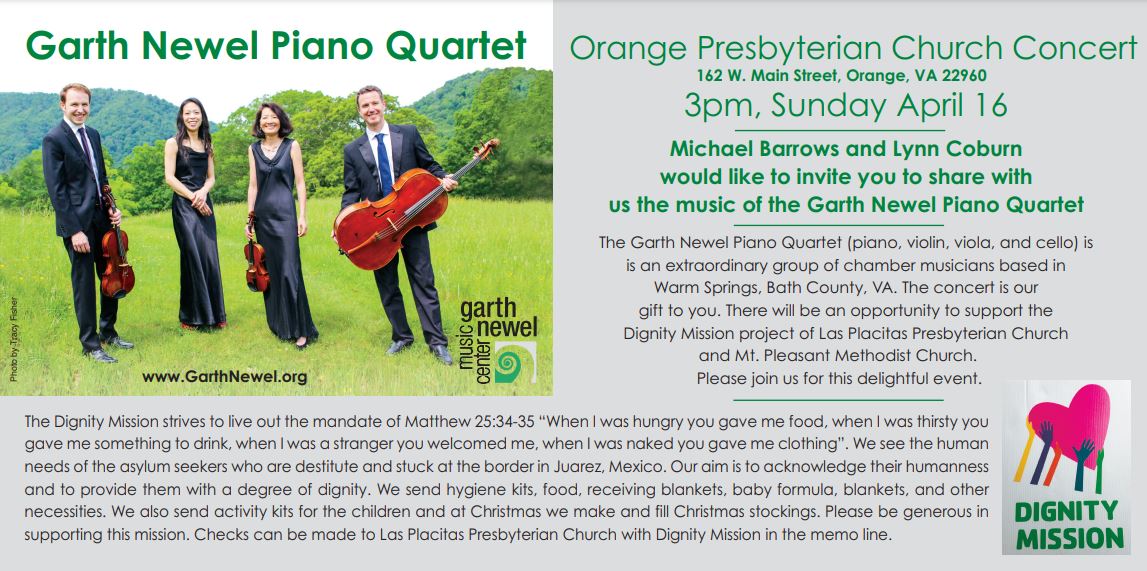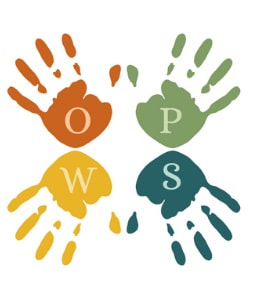 Sunday, April 30, 2023 was a very special date. The Orange Presbyterian Weekday School students, parents, and staff participated in Sunday worship. As pastor Denny Burnette pointed out, "our church does not simply have a preschool. The preschool is an integral part of our church. A very important part of our church’s ministry, and we are a family together.” To prove his point, Denny asked current students and parents to raise their hands. Then he asked any former students to raise their hands. Then he asked any who had children or other family members attend OPWS to raise their hands. There were ninety people in the sanctuary. Virtually every hand was in the air. After the service, there was a reception for friends and families. Denny promises this won't be the last OPWS Sunday. Now that's something to look forward to!
- Ralph Graves Communications Team Leader
0 Comments
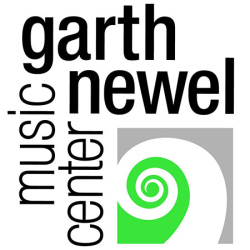 Garth Newel Piano Quartet Sunday, April 16, 2023 Orange Presbyterian Church Gustav Mahler: Piano Quartet in A minor David Biedenbender: Red Vesper Johannes Brahms: Piano Quartet No. 2 in A major, Op. 26 The Garth Newel Piano Quartet performed an engaging program at Orange Presbyterian Church. These are world-class musicians, so of course the playing was at the highest level. A pleasant surprise was the church's acoustics. The sanctuary's brick wall would seem a detraction. Audio waves bouncing off of hard surfaces tend to sound harsh. But the acoustics proved ideal for chamber music. The bricks' rough surfaces slightly diffused the sound, giving it more warmth. Plus, the ambiance of the space allowed the sound to travel. Reverberations were audible enough to further smooth the sound. But they weren't loud enough to muddy it. The sanctuary's Andrews Steinway piano received a workout. And it was up to the task. Jeannette Fang played the instrument with a full range of expression. She could make it whisper beautiful melodies or thunder massive chords with authority (and everything in between). The ensemble sound of the quartet was first-rate. These musicians know each other well and play with one accord. They embodied the highest ideal of chamber music. That is, to make the music seem like a spontaneous conversation between friends. The first half of the program featured a student work by Gustav Mahler. Composed in 1876, the Piano Quartet in A minor is a single-movement torso. Mahler abandoned the piece after completing just the first movement. Stylistically, the music embodied the emotional excess of the late-Romantic era. And so did the quartet in their performance. First violinist Teresa Ling played with a rich, dark tone that oozed emotional drama (or was that dramatic emotion?). The ensemble emphasized Mahler's melodic motifs each time they appeared. This helped guide the audience through this unfamiliar work. The power of the tutti unison at the end was thrilling to experience. Next was a short work by American composer David Biedenbender. Red Vesper evoked a spiritual moment in the woods. In this composition, silence was as important as sound. Biedenbender used both effectively. Most impressive were the rock-steady harmonics played by the strings. They're not easy to play. Yet the tones never wavered. And all three instruments were perfectly in tune with each other. 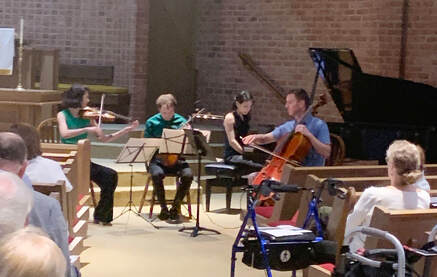 Johannes Brahms' Piano Quartet No. 2 in A major, Op. 26 made up the second half of the program. Brahms completed the second of his three piano quartets in 1861 when he was 27. As violist Fitz Gary pointed out in the introduction, the work is a mix of influences -- Beethoven, Schubert, Schumann, and Bach. Yet Brahms brings it all together in a cohesive whole lasting 50 minutes. Here the Garth Newel Piano Quartet really shone. They played the slow second movement with such delicate beauty that applause broke out at the end. It wasn't a breach of concert etiquette -- rather. it was a spontaneous response to the music. The performance was just that good. The quartet had a warm yet bright sound throughout the piece. And when the finale kicked in, the musicians cut loose. The finish was furiously fast and joyful. It was an exceptional afternoon of music-making. As the eighty-one people in the audience can enthusiastically attest. - Ralph Graves Program Director, CharlottesvilleClassical.org, host of "Classical Sunrise" on WTJU.net OPC Communications Team Leader The Flowering of the Cross is a beloved Easter tradition here at OPC. It's a simple concept, yet it provides such a powerful witness. For the Easter service, a small wooden cross sits next to the communion table. It's two pieces of gnarled wood, crudely nailed together and covered with chicken wire. It's a small ugly reminder of Christ's crucifixion. But then something wonderful happens. During the singing of the first hymn, members of the congregation come forward. In their hands are flowers. Some bring blooms from their gardens. Others have flowers the church provided when they entered. 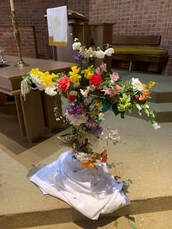 They come forward and insert their flowers into the chicken wire. Just a few come forward at first, but soon the pews empty. The cross disappears from view, surrounded by people with flowers. And when everyone returns to their seats, the cross has been transformed. It has become a cross of flowers, full of vibrant colors. What was a symbol of death has become a symbol of life -- the new life in Christ. 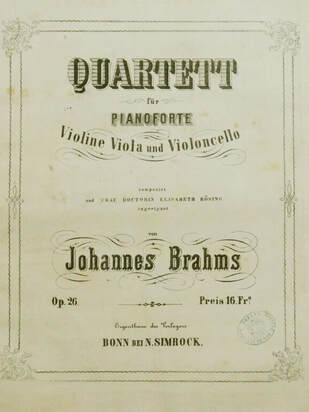 So what exactly is a piano quartet? It's not four pianos. The name denotes that a piano is one of four instruments playing together in a chamber ensemble. A traditional piano quartet consists of a piano + a string trio (violin, viola, cello). A piano quintet would be a piano + string quartet (2 violins, viola, and cello). A piano trio is understood to be a piano + violin and cello. What's a chamber ensemble? The term originated in the late 1770s. It described the small groups of players who performed in a home's chamber or salon. This was in contrast to larger ensembles that played in court ballrooms or concert halls. Franz Joseph Haydn and Wolfgang Amadeus Mozart were early proponents of chamber music. Haydn's considered the father of the string quartet (2 violins, viola, cello). He wrote 68 of them! But Haydn wrote significantly fewer piano quartets -- only thirteen. Mozart was also a prolific chamber music composer. Before he died at age 35, he had written 23 string quartets, but only two piano quartets. The first, composed in 1785 was deemed too long and too difficult to play. Mozart wrote a second, simpler one in 1786. Modern players consider both masterworks. Other composers have written piano quartets. Ludwig van Beethoven and Felix Mendelssohn wrote four each. Johannes Brahms and Robert Schumann each composed three. Antonin Dvorak and Gabriel Faure only managed two apiece. But all are standard repertoire. And many other composers have contributed to the genre. What can I expect to hear?
The essence of chamber music is collaboration and dialogue. You can expect to hear sections where the piano and strings play in opposition. You'll also hear each individual instrument taking an idea and handing it off to the others. You may hear each instrument take a solo, supported by the other three. You'll even hear duets between two of the instruments. Examples of all these combinations can be found in the video above. The piano has a wide range of 88 notes. The three stringed instruments have overlapping ranges, and combined they rival the piano's. So there's a lot for a composer to work with -- and the best take full advantage of it! When do I applaud? That question makes classical music more intimidating than it should be. Up until the early 20th Century, audiences applauded whenever they heard something they liked. Sometimes it was at the end of a section, sometimes in the middle. The way audiences still do for virtually every other genre of music. Somehow, a tradition arose that one should only applaud at the very end of the work, so as not to break the mood. Most piano quartets have more than one movement, though, so it's sometimes not obvious when that is. Think of movements like chapters in a book. Each movement has a beginning and an end, but it makes up part of the overall piece. Movements carry the narrative forward. Some are short, some are long. First movements are usually the most dramatic to set the stage. Final movements are generally fast and furious to end on a high. Second movements are normally slow and lyrical. Third movements (if present), are often light and dance-like. Each movement has a defined start and stop. When it ends, there's usually a pause (sometimes a long one if the musicians have to retune). Then the next movement starts. So how do you know when the piece finally ends? If there's a program, the movements are usually listed. So you could follow along that way. Personally, I recommend just enjoying the music. Don't sweat the "rules" If you applaud at the end of a movement because you're moved to -- don't worry. Your genuine response to the music will be appreciated by the musicians. Want to wait until the end, but aren't quite sure which stopping point is the final one? Relax. The musicians will let you know when it happens. If they're just stopping between movements, the musicians usually stay poised to play. When they finish the piece, they'll break their poses. The string players will put down their instruments and the musicians will face the audience. And then you'll know. But really. Don't worry about the "rules." Go, enjoy, and let the music sweep over you. And respond as it moves you to. That's what I do. Ralph Graves The Garth Newel Piano Quartet will be playing a concert in the Orange Presbyterian Church, and you're invited! Michael Barrows and Lynn Coburn are hosting the concert, and they've invited members of OPC to attend. Congregations from other churches in Orange, as well as the area's musical associations (such as the Orange Community Band and Chorus) were also invited. The concert takes place at 3:00 pm, Sunday, April 16 in OPC's sanctuary, The Garth Newel Piano Quartet is an internationally-recognized chamber ensemble. It consists of Teresa Ling, violin; Fitz Gay, viola; Isaac Melamed, cello; and Jeanette Fang, piano. This will be world-class performances, to be sure! Want to know more about the ensemble? The quartet was recently interviewed on WTJU's "Offstage On-air" Sunday arts program. Click this link to hear the program from the radio station's archives. The video below will also give you an idea of what to expect. There will be a free-will offering plate for two organizations Mr. Barrows and Ms. Coburn are associated with: Mt. Pleasant United Methodist Church in Lousia, and the Dignity Mission of Las Placitas Presbyterian Church, Placitas, NM.
Our sanctuary has exceptional acoustics for chamber ensembles. This is one concert that shouldn't be missed. Need more info? Read our Piano Quartet primer for background on the genre and what to expect if you go. |
Archives
April 2024
Categories
All
|

